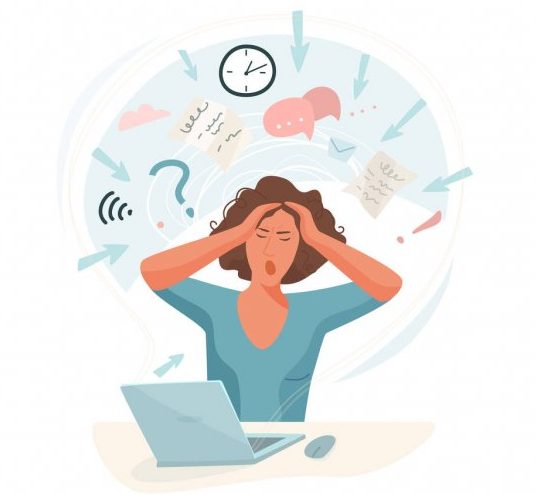
Have you ever had the experience of your computer or laptop just shutting down because of too many tabs being open? It just crashes doesn’t it? With an overload of information in it! Well, our human brains are just like a computer, but imagine the same thing happening to an individual with autism.
The brains of an individual with autism are more receptive to all sights, sounds and smell as compared to a neurotypical brain. However, when an information overload takes place, it stops functioning effectively! But what causes this shutdown? This is known as “Sensory Overload” and could lead to Sensory Processing Disorder in individuals with Autism.
So what really is Sensory Overload?
As the name suggests, sensory overload happens when one or more of your 5 senses gets overstimulated i.e. when you’re getting more input from your 5 senses than your brain can sort through and process. For example, multiple conversations going on at the same time in a room, loud traffic noise, loud bright lights at a concert can all make the brain feel overwhelmed and thus reduce its functioning effectively.
While practically anyone can experience sensory overload, with varying levels of triggers for different people, this condition most commonly occurs in people with Autism, PTSD (Post Traumatic Stress Disorder) and other NDDs (Neurodevelopmental Disorders). Now that we know what sensory overload entails, let’s take a quick look at some of the signs that are noticeable when an individual on the spectrum undergoes a sensory overload:
What does sensory overload feel like?
There are certain ways to know if your child or someone on the spectrum is dealing with a sensory overload. You might wonder: How would I know if I have sensory issues? Here are some ways to know the same:
- Lack of focus due to competing sensory input
- Extreme levels of irritability
- Urge to cover your ears or shield your eyes from sensory input
- Feeling overly excited or “wound up”
- Stress, fear, anxiety and panic attacks about sensory stimulus
- Higher levels than usual of sensitivity to textures, fabrics, clothing tags, or other things that may rub against skin
- Children with autism might show an aversion or attraction to a certain kind of textured or flavoured food
These triggers of sensory overload might lead to your child with autism feel hypo-sensitive or hypersensitive to certain tactile, visual, auditory, olfactory responses which could absolutely be minor or negligible for the neurotypical community! This in turn might lead to a meltdown for an individual with autism where they completely dissociate from the situation due to being overloaded with stimuli from the environment. But what is actually causing this sensory overload?
What is really causing this sensory overload in our brains?
The human brain receives a number of sensory inputs from the environment via the sense organs. The sense organs convey the information to the sensory nerve cells (neurons) which then relay the same bit of information to the brain. The brain then interprets the information and guides the motor neurons on the reaction of the human body.
But when there’s competing sensory information, the brain can’t interpret it all at the same time. This happens in a sensory overload and for some people, this feels like getting “stuck”; the brain can’t prioritize what sensory information it needs to focus on.
The brain then sends the body the message that it needs to get away from some of the sensory input that is surrounding it. The body feels trapped by all the input and starts experiencing a fight or flight reaction, increasing your adrenaline levels and setting off into a panic attack.
Autism and Sensory overload in children
Once you learn to recognise the early signs of sensory overload, it can help you manage your child’s reactions. If your child cries uncontrollably when their face gets wet, reacts intensely to loud noises, or becomes anxious before entering a group gathering, your child may be experiencing sensory overload. So how would you calm your child facing sensory overload?
Once you’ve learned to recognize your child’s triggers, you can slowly teach them how to recognize sensory overload. You can be proactive about sensory overload by thinking creatively about how to reduce sensory input when your child is in certain triggering situations.
Having a weighted blanket to apply pressure on the body, wiggle seats, therapy putty are just some of the ways you can manage your child’s sensory overload to prevent a meltdown or a panic attack. Identifying situations where your child is more likely to have a sensory overload due to numerous triggers like loud noise, bright lights, and avoidance of these can help you manage the condition better.
Treatment for Sensory Overload
While there is no one stop solution for sensory overload, most of the treatment boils down to identifying the triggers for an individual with autism, and working on management strategies and dissociation techniques with a medical practitioner or a therapist. Sensory integration and occupational therapy are some of the therapy modes that have been proven to be extremely beneficial and effective in managing sensory processing disorder. Similarly, some medications specifically have been proven to improve sensory processing in people with autism.
One of the major telltale signs of autism in most children is difficulty in maintaining eye contact and having social and communication barriers. These can be visualised in a public environment setup like the child’s school or play area where there are a number of stimulation for them. In this case, identifying the triggers and working on them with an occupational therapist, behavioural therapist and the child’s paediatrician can be helpful for early intervention.
If your child is experiencing sensory overload, try to give them words they can use to explain the way they feel. If it’s happening to you or your child often, speak to your doctor about possible techniques to manage the condition better.




You must be logged in to post a comment.